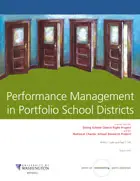Under pressure from state standards-based reform and No Child Left Behind, and with increasing competition from schools of choice, urban school districts are looking for ways to offer a high-performing mix of schools that meet the diverse needs of their communities.
Many districts see themselves as portfolio managers, operating some schools in the traditional way, hiring independent groups to run other schools, and holding all schools accountable under the same performance standards.
Portfolio management requires school districts to do three things they were not designed to do: judge the performance of individual schools, decide which are effective enough to continue supporting, and decide whether to shore up struggling schools or create new ones. Districts currently adopting a portfolio strategy, partially or fully, include New York, Chicago, New Orleans, Denver, Philadelphia, Hartford, and the District of Columbia. Many other districts are considering the strategy.
Performance Management in Portfolio School Districts provides ideas for portfolio school districts and others that are trying to manage schools for performance. Based on studies of other government agencies and businesses that have shifted from inputs- to performance-based accountability, this report contrasts traditional compliance-based and the new performance-based accountability, suggests how portfolio districts can develop necessary technical and staff capacities, and shows how portfolio school districts can organize to:
- Judge schools on performance
- Accept some school closings as necessary and desirable
- Maintain neutrality about who runs a school
- Make sure they are never stuck with an unproductive school and no alternative
- Constantly search for new school providers and more effective forms of schooling
- Look outside the district central office to independent providers and voluntary school networks for advice and assistance to schools
- Use common standards to judge schools but pay attention to unique circumstances
As the report concludes, a portfolio strategy transforms the role of district central offices and makes most of their current functions unnecessary. Districts committed to portfolio strategies will need to eliminate many existing central office structures to avoid mixed signals about whether schools will be judged on performance or compliance. Those savings could pay the operating costs of portfolio oversight once a district’s basic capacity has been built.






